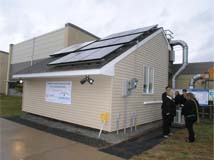New Connecticut solar program exceeds expectations
 Just over a month ago (March 2) Connecticut introduced the first, $2.5 million round of incentives under its Residential Solar Investment Program. And it’s proved wildly popular. As of April 5 the state approved 126 projects totaling $1.4 million in state incentives.
Just over a month ago (March 2) Connecticut introduced the first, $2.5 million round of incentives under its Residential Solar Investment Program. And it’s proved wildly popular. As of April 5 the state approved 126 projects totaling $1.4 million in state incentives.
This is the first offering in a two-step, $7.5 million round of solar incentives being offered through Connecticut’s Clean Energy Finance and Investment Authority (CEFIA) to residents, according to spokesperson David Goldberg. Under the first step residents can qualify for an up-front Expected Performance-Based Buydown (EPBB) incentive rebate of $2.45 per watt for installing solar systems up to 5 kilowatts in size and $1.25 per watt for systems up to 10 kilowatts. Or they can qualify for a Performance-Based Incentive (PBI) of 30 cents per kilowatt hour produced over the next six years. The latter allows homeowners to finance their projects through a third party with low to no up-front costs.
“We did not expect the level that we’re seeing 30 days in terms of the number of approved projects or the rate of applications for the program. I think we’re seeing three to four approvals a day which a is a very good response,” Goldberg said. The programs are proving popular despite incentives covering less of the cost of a system than the previously did.
The funds are anticipated to go quick. “We never expected the first two steps to consume a full year. Step one is a $2.5 million investment. Step 2 is a $5 million investment. We anticipated step 1 would be the quickest,” Goldberg said.
When funds for the first step are fully committed CEFIA will release funds for a second step albeit at slightly lower levels. Systems up to 5 kilowatts will qualify for a rebate of $2.10 per installed watt and systems up to 10 kilowatts in size will qualify for 90 cents per installed watt. Payments under PBI will fall to 24.3 cents per kilowatt hour produced.
The offerings are part of a larger $40 million incentive program. “When we get to the end of the $5 million [in step 2] we’ll announce the next steps and we’ll do so in a timely manner to allow market participants to react,” Goldberg said.
CEFIA is collecting data from the incentive program and looking at averages to help set future steps. “It is all intended to lead us to establish sustainable steps to the program to achieve goals set by the Governor and legislators,” Goldberg said.
The program will also hopefully benefit from the state’s SunShot grant to reduce the soft costs of solar. The state is focussed on simplifying permitting and other non-hardware costs through the grant. “If we do a good job with that we make solar more attainable to a larger population,” Goldberg said. By doing so the state can also lower the amount of rate-payer-based contributions to support such projects.



